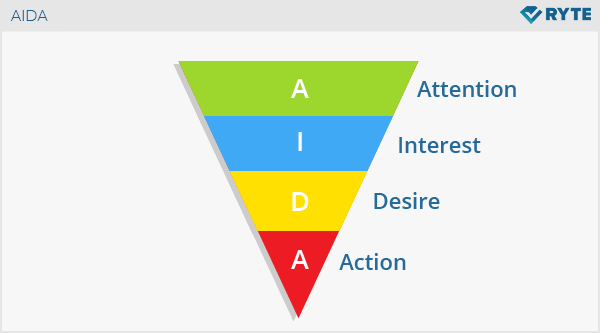Most likely, you’ve come across the term “a sales funnel”. It’s constantly being repeated as a business-boosting mantra, something that will transform your company into a money-making machine. Therefore today, we’d like to introduce you to a sales funnel concept and explain what the sales funnel AIDA model is and how it’s related to the sales funnels.
1. What is a Sales Funnel?
In short, a sales funnel is a way to visualise a multi-step process that illustrates how prospects convert into buyers. With the help of a sales funnel, you can identify your customers’ actions at each stage of their buying cycle and find ways to help them make that purchase decision.
The idea of a sales funnel actually refers back to the “purchase funnel”, developed by E. St. Elmo Lewis, an American advertising advocate. He created a consumer-focused marketing model that portrayed the theoretical customer journey from the moment a brand, a product, or a service attracts attention to the point of purchase of that product or service.
You’ll find that many similar terms are being used to refer to it, for example, the sales funnel, the marketing funnel, the conversion funnel or even the customer funnel. But while it has many names, it basically refers to the same model – the purchase funnel and the AIDA model.
2. The AIDA Model
The AIDA model shows how a consumer moves through a series of steps when making purchase decisions. AIDA stands for Awareness, Interest, Desire and Action – the four main stages of a purchasing journey.
3. How Can the AIDA Model Help You Create Your Sales Funnels?
Now that you know the main four stages of a customer sales journey, you can analyse the steps your customers are taking to make their purchase decisions. Find out what kind of information they are looking for and where. To build a sales funnel, you should be asking questions to help you identify where you can step in as a seller:
- Awareness: how can you attract the customer? Knowing that the attention span window is very short, your tactics need to make sure you can quickly grab your contact’s attention. This step is for creating brand awareness, build relationships, create an affiliation with your product or service.
- Interest: once you’ve captured your customers’ attention, how can you keep them engaged? What information do you need to share with them to keep them interested in learning more about the benefits and advantages they can get from your product or service? How can you grow that interest to encourage the customers to learn more?
- Desire: while you’re generating interest to keep your customers engaged, it’s time to convince them that your offer is what they need.
- Action: what actions do your customers need to take to convert? What are your CTAs? Is it easy for your customers to act on them?
4. The 6 Steps That the Seller Should Take
The AIDA model defines 6 steps that a brand (or the seller) has to take:
- Secure attention
- Generate interest and hold that attention
- Create desire
- Build confidence and trust
- Secure decision and achieve action
- And, finally, create customer satisfaction, contentment and even happiness
It’s all based on buyer psychology. Whatever your product is – a physical or a virtual one – the main steps are the same. Your sales funnel should be generating leads, then proceed to lead nurturing, generate sales and, in the end, create customer satisfaction.
5. Why Do You Need to Develop a Sales Funnel?
It’s probably not a surprise that most of your prospects will not buy after the first browse of your website or e-commerce store. Especially if they have just discovered your business. It usually takes some time to come to a buying decision: your prospect will go through the above-defined steps. On some occasions, the decision making can take days or even weeks – it depends on the product and the industry.
A sales funnel will help you recognise these steps – and identify these relationship-building opportunities where you can be present to encourage them to progress further through the funnel. With the sales funnel, you can introduce suitable lead magnets at the right time, easily present the information they might be looking for. Build that trust and relationship between you and the customer.

6. Benefits of a Sales Funnel
A good sales funnel will help you see how many leads actually enter your funnel – not just simply display the conversions. Knowing where your leads are dropping off from your funnel will allow you to optimise it and make it more effective. But conversions also matter. With a strong sales funnel, you will bring in more leads and potentially more customers. More customers, more revenue.
Sales funnels can help you build better, more accurate sales forecasts for your future business growth. After running the funnels you can identify the trends and find your conversion rate. Then you’ll be able to make more accurate plans to achieve your goals.
Not only that, a good sales funnel will help you find appropriate marketing points and adjust the content to meet the customers’ expectations. Keep them interested and engaged. Marketing automation platforms will provide the tools to create automated flows for these sales funnels. And with automation, you can save so much time and build error-free, real-time flows.
Build Your Sales Funnel
Now that we’ve introduced you to the concept of a sales funnel, it’s time for you to analyse your business through the AIDA model lens. Find ways to attract the customers, keep them interested and engaged, help them continue to progress through your sales funnel, and arrive at a purchase decision quicker. A well-planned sales funnel will definitely help you boost your business.


